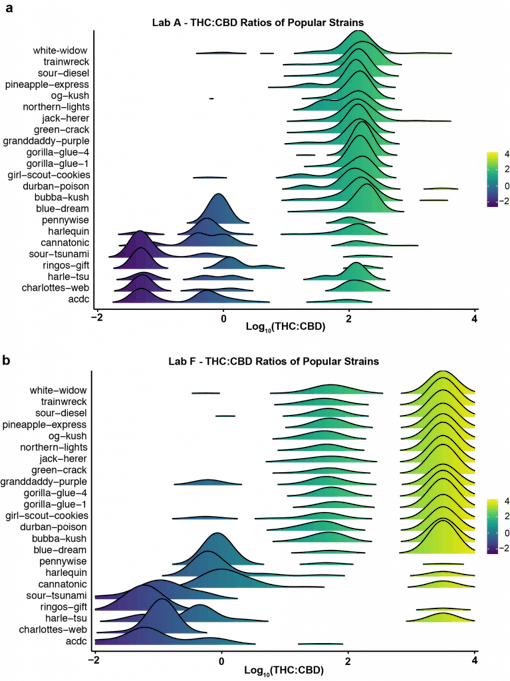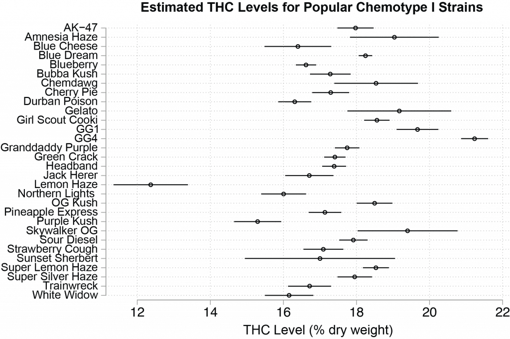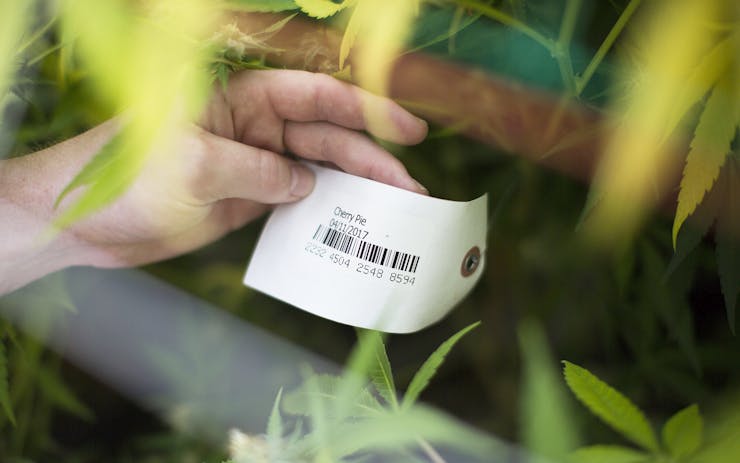When it comes to understanding the cannabis experience, conventional wisdom says strain names are one of the best places to start. Northern Lights might engulf you in dreamy euphoria, while Sour Diesel might rev up your engine. The common notion that strain labels accurately tell consumers what to expect, however, has recently come under sharp scrutiny.
A new analysis of state lab testing data found a mess of inconsistencies in strain qualities from lab to lab.
“Scientifically speaking, most weed strains are bullshit,” a Motherboard article said last year. “The most accurate way to describe weed,” the piece concluded, “is its THC and CBD content rather than its genetic heritage.”
A report published Wednesday in the journal Scientific Reports, co-authored by Leafly principal research scientist Nick Jikomes and Harvard graduate student Michael Zoorob, seems to corroborate the ingredients-based approach. At the same time, it strengthens the idea that particular effects can be predicted by a strain’s name—as long as the strain is accurately identified.
Analyzing publicly available cannabis-testing data from Washington state, the researchers compared THC and CBD results from various state-licensed laboratories. Looking to identify areas of inconsistency, they compared results for a selection of popular strain names. What they found: a mess of inconsistencies.
The Three Chemotypes
Cannabis strains, the report says, can be divided into three chemotypes: THC-dominant, CBD-dominant, and balanced. The proportion of CBD to THC that ends up in a given strain is a function of two different enzymes that act on the molecule CBGA during the plant’s life cycle. One of the enzymes converts the molecule to CBDA, which can then be converted to CBD. The other converts CBGA into THCA, the precursor for THC. How much of each enzyme a given strain has—and thus the relative THC and CBD levels—is determined by its genetics.
In the Washington data, Jikomes and Zoorob found that many samples labeled and sold under a specific strain name in fact yielded test results well outside the range of the chemotype they were associated with.
“If a strain name is going to mean anything, you can’t have multiple chemotypes” associated with it, Jikomes said. More simply put, if a product claiming to be the famously high-CBD, low-THC strain Charlotte’s Web comes back from the lab with a CBD-to-THC ratio of less than 5:1—the threshold for the CBD-dominant chemotype, as defined in the report—it can’t functionally be what we know as Charlotte’s Web.
Two Labs, Two Very Different Results

These two charts compare the THC:CBD ratios in popular strains, as analyzed by two different Washington state-certified labs. (Scientific Reports)
One Strain, Two Labs, Differing Data
Does this mean strain names are meaningless? Far from it.
As it turns out, strain names actually can explain quite a bit of the variation in THC:CBD ratios, especially once results outside of a strain’s chemotype are filtered out.
Shop highly rated dispensaries near you
Showing you dispensaries near“The strain name is much more explanatory to the THC and CBD levels than I would have guessed ahead of time,” Jikomes said. “If we add in the terpenes, presumably we’d be able to identify differences between strains more clearly.”
In other words, while the most accurate way to predict a cannabis experience might be by knowing its cannabinoid profile, strain names can actually be a pretty good indicator of that. This is especially true when the data under analysis comes from a single lab.
Why so many inconsistencies in the state data? “Presumably, some of this, probably a fair amount of it, is mislabeling, intentional or unintentional,” Jikomes speculated. “Maybe a breeder got a seed and someone said, ‘This is Charlotte’s Web,’ and it wasn’t Charlotte’s Web.”
THC Levels for Each Strain Exist Within a Range

(Scientific Reports)
Needed: Biochemical Profiles
To combat inaccurate strain names, “what we really need is to have biochemical profiles of the material that people are buying,” says Dr. Ethan Russo, the director of research and development at the International Cannabis and Cannabinoids Institute. (Russo was a peer reviewer of Jikomes and Zoroob’s report.)
Unfortunately, Russo and the report both point out, most of those profiles don’t exist.
In order to have accurate biochemical profiles of cannabis, even ones limited to THC and CBD, data coming from the labs have to be accurate. Not only does that mean labs must be consistent from sample to sample, it also means results have to hold from lab to lab. “The adoption of universal industry testing standards will be crucial for comparing data across the many existing testing laboratories,” the report notes. “However, standardized procedures have yet to be adopted, and controversy exists about whether all laboratories are accurately measuring and reporting cannabinoid content.”
The authors cite a recent Leafly News investigation showing that one Washington lab, Peak Analytics, showed THC results consistently higher than those from its peers. Jikomes and Zoorob’s analysis found the same inconsistencies, even after controlling for confounding factors like mislabeled strains or inconsistent samples.
Amid the discrepancies, however, was promising news. Data from some of the labs the report looked at had similar characteristics, suggesting the different companies are already using sufficiently similar methodology. These labs, Jikomes said, tended to be those he and Zoorob had classified as “low-THC reporting” and whose results were closer to the data produced by independent researchers.
When it comes to drawing conclusions from the data, a few bad apples can spoil the whole lot. “I wanted to be able to do chemotyping using this type of data on a large scale,” Jikomes said. “But I realized I couldn’t just take the data from anywhere. Even if every single lab shared data with me, I would actually be worse off as a data scientist, because the measurements are so different between labs.” That roadblock inspired him to do the report, which he hopes will be a call to action for lab reform.
Testing Guidelines Exist, but Aren’t Enforced
As the researchers note, there isn’t any real roadblock to lab reform. Both the American Herbal Pharmacopoeia and Americans for Safe Access provide testing guidelines for cannabis. The obstacle, the report concludes, is a matter of those guidelines not being implemented or enforced:
“Reliable cannabis laboratory testing is an attainable goal. In the absence of federal regulations in the United States for the foreseeable future, it will be incumbent on state regulators to implement universal testing standards for cannabis laboratories. But states have extensive experience in this arena, regulating laboratories that analyze drinking water and evidence from crime scenes. They need only hold cannabis laboratories to similar standards.”
To do that, the report recommends, states should mandate that labs adhere to standards like the American Herbal Pharmacopoeia’s, as well as obtain third-party accreditation from groups like the International Organization for Standardization. To ensure compliance, the report recommends that states conduct regular “round-robin” audits of facilities.
The goal is to reach a point where a strain is the rough equivalent of a wine grape. You know what flavor profile you're getting with a pinot noir, but each producer can put their own stamp on it.
The entire issue of testing accuracy is something of a chicken-and-egg problem, Russo said. Cannabis consumers haven’t demanded chemically accurate profiles of their cannabis, and so the industry hasn’t provided them—and state governments haven’t mandated them.
“Standards don’t happen unless there is either a mandate to do it or it’s demanded by the consumers,” Russo said. “What I tell people when I speak is, ‘You need this information and you need to ask for it.’”
Lab standardization, the scientists said, would allow researchers to begin the arduous but important task of mapping strain names to their non-arbitrary characteristics, like cannabinoid and terpene content—and then, theoretically, to the effects produced by those components.
The end goal, Jikomes said, is to reach a point where a strain is the rough equivalent of a particular wine grape—you generally know what kind of flavor profile you’re getting with a pinot noir, but each producer can still put their own stamp on it.
The Human Factor Adds Complexity
When it comes to predicting effects, researchers have the added variable of the human endocannabinoid system, which is unique from person to person, but nailing down what compounds are in a given strain and what effects they’re associated would still be a huge step forward.
“We ought to be able to segment cannabis products by what they’re made out of,” Jikomes said. “You would at least be able to make the experience consistent for each person, even though the experience wouldn’t be identical for any two people.”
Given how many moving parts are involved, developing an understanding of how cannabinoids and terpenes produce the specific effects they do might take a long, long time. But accurately measuring those cannabinoids and terpenes doesn’t have to, Russo said. “If people are really interested in having the accurate information, the technology is clearly there. We could have this so it means something, and people could have a good idea of what they’re buying. But so far it hasn’t happened here.”
“It’s all within reach,” he said, “it just requires that people want to do it.”
Editor’s note: The study’s authors included the publicly available testing data as a supplement to the article, allowing researchers to mine the full dataset for further insights.





